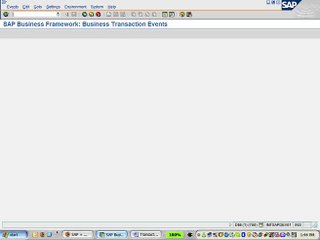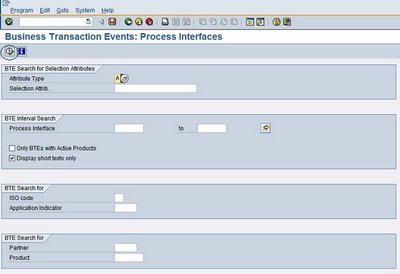On this post I would like to look at how the system has been designed to transfer balance sheet items to profit centers using the transactions 1KEH, 1KEI, 1KEJ, 1KEK. Often I have come across situations where the total balance of balance sheet accounts on a report painter report based on the library for GLPCT doesn’t match with the total of the line items on the called up report. This is not a Bug rather this is how the system has been designed.
Search The SAP Consultant
Friday, November 24, 2006
Profit center balance sheet
Friday, October 06, 2006
SAP Business Transaction Events

Next we have to find the process interface for duplicate invoice check! To do that, follow the following steps.
- Select the menu as stated below

- Execute the info system as stated below

- All the processes will be shown below

- Select the process 1110 and click on “Sample function module” as stated below

- Copy the sample functional module “SAMPLE_PROCESS_00001110” and create “ZSAMPLE_PROCESS_00001110”. Put the customized logic in the functional module “ZSAMPLE_PROCESS_00001110” and activate it!

- Now go back to FIBF and execute the menu as shown below

-
Define a new product and activate it

-
Now go back to FIBF and execute the menu as shown below

- Assign the function module “ZSAMPLE_PROCESS_00001110” to the process “1110”and the product that was defined in the earlier step.

-
Bingo!!!!!! Now every time when a vendor invoice is being posted the invoice check will be carried out using the custom logic built into the function module “ZSAMPLE_PROCESS_00001110”. But make sure that the “double invoice check” tick has been put on the relevant vendor masters!
Sunday, April 02, 2006
Allow the company to grow!
Thank you very much for all your comments.
This time I would like to give a small tip. In a business environment, all the companies will eventually grow. A well thought out ERP implementation will never give any problems when the company would like to expand its operations in the future.
For example, we all know that more than one company codes in SAP can be grouped under one controlling area for management accounting purposes. If a controlling area has the currency type company code currency, it’s not possible to have company codes with different local currencies under that controlling area. So if a new company with different local currency has to be added to the same controlling area in the future, it would be impossible.
So it’s always critical to look into future expected development of the company and give room for it when an ERP is being implemented. After all an ERP should never be a bottleneck for the company’s growth.
I wanted to share this with you since I had come across this issue with one of my new clients. I hope this tip would be useful to you.
